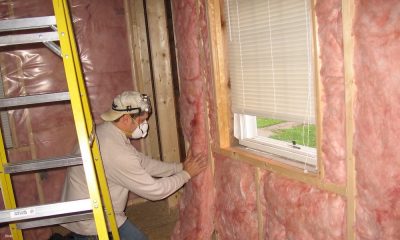Mindset
Making your money work for you – A quick introduction
As an avid property investor and owner of Capitalise Investments, understanding how to use money to make it work for you is vital to what I do on a daily basis.

As an avid property investor and owner of Capitalise Investments, understanding how to use money to make it work for you is vital to what I do on a daily basis. I often get asked how one would go about making more money or how do you get your feet on the steps of property investing, or I’ve got too many outgoings to focus on any investments. The latter being fundamentally the problem and many people fall straight in to this trap.
Formerly from the UK, I grew up in mediocre town, went to mediocre school and I followed in the footsteps of my parents. I went to school to get a great education hoping that one day I’ll be able to afford anything I wanted. Soon it was time to leave studies and focus on my “career”. I got a job, I earned, I paid my bills and got a car to match my job. Without realising at the time, that was the biggest mistake of my life. Obtaining the car through finance and having that liability to pay every single month. This is the first signs to becoming financially unstable and ultimately forming part of the daily rat race that will see me trapped forever.
To make your money work for you, there is one simple rule and I only learnt this much later in life. Focus on assets as opposed to liabilities. It’s that simple. Liabilities being everything that takes money away from you, finance, mortgage, credit cards, personal loans, those are the things that will ultimately make you poor. Think about it, you go to work to get paid, you pay off your mortgage debts, car loans and the circle begins again.
However the assets – this is something that puts money in to your pocket. If you want to be rich, spend your life buying assets and I have chosen to work within tangible assets, something you can see, feel, stay in and sell on. I work with tangible assets within emerging and distressed markets that not only appreciate, but you earn from rental income, rental income that puts money in to your pocket every single month to supplement your income from your daily job.
Making your money work for you is easier than you actually think. For example, If you want a nice new car, instead of thinking, I can’t afford the car – why not think, HOW can I afford the car. Personally I would look for money making assets; my chosen example would be real estate. I carefully invest in to an emerging market or a distressed market that will generate me income, with that income I’ve generated from my money making asset; I can afford to pay for the car loan without losing any liquid cash. Once the car is paid for, I now have an income generating assets that has appreciated in value, plus a nice new car that is mine to own 100%.
Depending on how much money you have to start with, you could use the example above to generate you future financial success to overcome mortgage repayments, car loans, credit card bills and to secure that all important financially free future. Once you have obtained the asset, it will usually look after itself without any support from you whatsoever.
So as my first post and if you’re reading this, take a look at what you can cancel out in your life to free up more cash to focus on building that asset column of your own. Take a look at your cash flow, where you get your cash and where it goes because that will tell you a story of how you handle your money.
Remember, it’s the Assets vs. The Liabilities and now is the time to learn the difference between the two.
I run a small investment consultancy and I’m always seeking ways to further my wealth creation through real estate, feel free to send me an email and follow us on twitter and Facebook.
Mindset
The Educators Catch 22: Knowledge to Action is Not a Scam
This post is not just about Knowledge to Action (accused by a small minority of people as being a scam) but for all the educators out there.

As I mentioned in my post titled “Is Knowledge to Action a Scam?” the bulk of people who complain about training courses are normally people who are trying to avoid the risk of changing their life. Risk is scary for many people so providing an opportunity to change their life can cause a lot of internal conflict.
Most people like to stay “safe and comfortable” with their life even though, deep down, they are very aware that this is not how you reach your dreams and goals.
People who complain about the cost of a course or the fact that the educators don’t provide lunch tells me this person is looking for any excuse to invalidate the chance to change.
If you do want to change your life and you have heard about a course that could help you get closer to your goals, but you see a negative review or comments about the course, ALWAYS look behind the comments and look at the person who wrote the review. You will normally find a person who constantly complains and has a “safe and comfortable” approach to life.
Is this how you want to live your life as well?
I will always ask the people who attended the course to see what value they got to help me make a decision – not the “tire kickers of life”.
Mindset
On Inspiration
A friend and reader recently mentioned they were hoping for inspiration from these blogs… we trust this will suffice….

A friend and reader recently mentioned they were hoping for inspiration from these blogs… we trust this will suffice….
Sonam and Bayermaa, lived in the great mountains, near Paryang in the heart of western Tibet; a place where the four great rivers of South Asia originate, from slow, crushing, time-wearing glaciers as old as the planet itself; the air is always full of gnawing, biting vitality, and life is as bright and real as the contrast between snow on the far flung slopes and the yawning gulfs between the valleys.
Sonam and Bayermaa are happy, and modestly proud with reason. Sonams only son is strong and vital, and a walking painting of father; the three daughters Bayermaa bore are all sharp of wit, keen of frame and visage, and will be well-contested when they come of age in the small village. The family work hard and willingly, either in the long hours of summer or a little more frenetically when the clouds settle in for winter. The fields are well tilled, and there is always tsampa and chang, butter tea and time available for guests or elders who are passing the family home. And so lifes melody has skipped along, with intermittent ups and downs, childrens bruises and tantrums and all the texture one might expect in a good life.
Yet Sonam was beginning to be troubled. The source of this abrasion he could identify, and so slowly it gained power, he became restless, and eventually the chang he put so much of his time into could not suppress this itch. He began to stir constantly at night, until Bayermaa could not help but be woken; yet Sonam could not tell her what bothered him, merely say “it’s nothing, it’s nothing”, and force himself to lie still. But by dawn, when he had been staring at the slate above him, Sonam could stand it no more.
When the family had all gotten about their work for the day, Sonam slipped away to seek out Anil. Anil was the oldest male in the village, frail, blinded by cataracts, yet alert and always willing to expound upon any matter in the village, although his thoughts might take quite some time and tea to be finally rolled out, like the bright little pebbles one would play with in his youth. Sonam explained this uncalled for and bothersome thorn had developed in his soul; he was aggrieved, he said to Anil “I have worked hard in my short years, I have good land and good people around me, my hands are skilled and I always contribute well when the men sit to ponder the seasons and workings of the valley together, I have by all gods, been most fortunate — why may I not be content — yet I feel, I feel, its not enough.. this is an unworthy feeling”
Anil considered his response a long time, and finally, said to Sonam, “many nights I have watched you, since you were a small boy. Now your family is grown, they do not need your chivvying and strong arms to lift them, Bayermaa is dutiful and a good mirror to you, yet your wits are undimmed and indeed, you are almost, idle” raising his hand to forestall the protest this word would bring. “I have seen you begin to reflect on yourself in the chang, yet there is no answer there, indeed I had hoped you would see this yourself. But it is now clear to me, you are now drowning in your own unused vitality. Why are you not using your strengths and mind to grow as a man and be beyond yourself?”
“Anil”, said Sonam, “I am an empty well, long I have thought, and yet I have no answer”. “Then you must seek inspiration, Sonam. May I suggest that you will not find it here, in the four walls of this valley you know so well. You need to climb Sonam, climb above and look beyond what you know.” “How then, should I do this, Anil?” Anil looked Sonam straight in the eye, and said — “it is a simple thing. You need many days tsampa, a strong hoe, and a good waterskin. You must climb (mount) Kailash and seek your answer from her at her peak. You should go now, before the winter truly arrives. I will explain this to Bayermaa. If you do not, this poison in your soul will grow, and then it will begin to infect us all — this is nature”
Sonam left that very evening. Many days he climbed, for Mount Kailash was 7 days walk to her feet, and then slowly, slowly he began the ascent. As he climbed past the first notes of the glacier, into the moraines and moss-struck boulders, he wondered, the first of many times, “ai, this madness, will it be my end?” The days passed and Sonam was now a stick figure on the bright slopes, able to be seen by hawks and bright adolescents maybe, but he was now truly ascending unheard of and terrifying heights. His boots were failing, blisters were formed and bleeding and he began to chafe and these constant pains and knocks to his spirit were indeed mounting against his resolve. Yet still he climbed. On the 14th day he nearly broke.
 The wind had begun in earnest, each step was a torture to his thighs, the snows were beginning to form above Kailashs brow, yet still he climbed, stumbling, slipping, now sliding back foot after foot, now gaining, his lungs stabbed at each breath with “the little knives” of winter. Yet still he climbed. He could not stop.
The wind had begun in earnest, each step was a torture to his thighs, the snows were beginning to form above Kailashs brow, yet still he climbed, stumbling, slipping, now sliding back foot after foot, now gaining, his lungs stabbed at each breath with “the little knives” of winter. Yet still he climbed. He could not stop.
For Sonam knew how, he would go on or perish, for walking down now was as bad an option as going up — he did not have the werewithal to make the bottom before he failed utterly in his strength. And so he faced his fate, turned his face to the slopes again, and lifted us foot up, again, again again… The following morning, at about that time of day when the first red rays court the clouds, the mists and echoes began to disperse, a cleanliness and sombre sparseness began to surround Sonam. 30 steps, 25 steps, 20 steps to go, 10, now a stumble, a sob, another step, 2 more, now 6 to go, and finally, when his heart truly was leaping out of his chest, he placed his hand on the summit if Kailash.
Many long minutes he kneeled there, eventually gaining back his breath, and knowing that he had achieved a tremendous victory over himself, and calm, clear and proud as he was, he still had no understanding of why he had needed to do it. It was then that Anils voice came to him. “Sonam, Sonam” the voice whispered. “Anil? Is that you”, Sonam replied peering all around him, wondering if he had gone mad. For there was nothing to be seen, save the hundreds of kilometres of mountain peaks, snow rock and ice and a blue sky so sharp it was blinding. There was no place here for a trifling human. “Sonam, Sonam, why are you here?” cried the voice. Sonam stood, and puzzled as he was, could not answer, until it came to him, Anil had said all those long days ago, “you must seek inspiration, Sonam” Swaying now, tottering in the breeze like an old man, Sonam finally replied ” I am here to seek inspiration”
The answer came back from the void —
“and here you are, Sonam, having become what you sought – here you are”
See you at the Masters, Sunday May 23rd
And folks, remember to enter our competition for Free tickets to the Masters day and Free copies of Seans book.
Mindset
Do Not Buy Coffee If You Want A House
A leading property investor has questioned why people on above-average wages cannot afford to buy a home after a report predicted dramatically falling home-ownership rates.

A leading property investor has questioned why people on above-average wages cannot afford to buy a home after a report predicted dramatically falling home-ownership rates. Property Investors Federation vice-president Andrew King said people on $70,000 a year had to look at their other spending – on things like coffee and cars – if they thought they could not afford a house.
“It might not be the house that you want to live in long-term, but you could buy a $350,000 house in Te Atatu, Glenfield, Panmure or Pukekohe,” he said. “People should spend less money on coffee and brand new cars and overseas trips.
“It’s up to them to save more. This is a culture of ‘I want it now, I want everything and I deserve it’.”
Yesterday, the Government floated the idea of property developers being forced to build low-cost homes in new estates to ease Auckland’s housing shortage. Housing Minister Chris Carter after two new reports revealed that New Zealand’s most populous region faces a severe housing shortage and must accommodate growing numbers of people who may rent all their lives.
A study on rental housing by Wellington consultants DTZ predicts falling home ownership, a big increase in the number of people renting – particularly young families and the elderly – and a growing demand for rental accommodation.
Even households making $70,000 a year are being locked out of home ownership, the report says. The city will need almost 55,000 new houses and flats in the next 10 years. But high development costs are strangling new-house building – a topic the second report examines.
The housing supply report by consultants Motu proposes speeding up resource consent approvals by financially punishing councils for delays. It also suggests abolishing the artificial city limit boundary, freeing new tracts of land for development.
Mr Carter said he had two solutions – a new law that is yet to win support from other politicians, and funding for shared-equity schemes, which he expects to be in next year’s Budget. The minister wants to force developers to build a proportion of cheap houses in large new Auckland estates. He said the move had succeeded in Australia.
“We would consider a home affordability bill to direct developers to build a certain portion of affordable housing,” he said.
“I’m enthusiastic about this but I need to convince my colleagues.”
He also favoured shared-equity schemes, in which the Government takes a stake in a house to reduce the cost for first-home buyers. The scheme had been introduced in Britain. Money for a pilot scheme should be made available in next year’s Budget, Mr Carter said, but numbers were yet to be decided. He promised to issue a report within six weeks outlining options, and said a new law could be passed next year. The reports sparked strong reactions from developers and landlord and tenant groups.
Patrick Fontein, an Auckland developer building a $400 million 500-house and apartment project at Orewa, was concerned about Mr Carter’s cheap housing proposals. Forcing developers to build low-cost houses in new estates was no solution to the affordability crisis, Mr Fontein said.
The move could lower the tone of new estates and force buyers of higher-priced houses to subsidise the cheaper housing. Mr Fontein said Mr Carter should work out ways to help people into existing homes rather than new housing, which was often out of reach for many first-home buyers.
Angela Maynard, co-ordinator for the Tenants Protection Association in Auckland, called for more quality rental accommodation and better security of tenure. Landlords should have to get warrants of fitness for their houses or flats before finding tenants, she said, to ensure minimum standards were set.
Landlords should also have to give reasons for eviction, which could be achieved by amending the Residential Tenancies Act. “At the moment, you can give a tenant 90 days’ notice without a reason,” she said. “We want landlords to give just cause for eviction.”
She said she was not surprised to find that people making up to $70,000 a year were faced with a lifetime of renting, but said the city’s property market was based purely on greed.
“Everyone in the equation is greedy and trying to get more and more,” Ms Maynard said.
The Salvation Army’s director of social policy, Major Campbell Roberts, called for swift Government action, saying very little had been done to alleviate Auckland’s crisis. The region’s state housing supply was under considerable stress, forcing many people into the private rental market where rents had risen in the last year, Major Roberts said.
He urged a wide-sweeping range of solutions, including more state housing and more care and professionalism from private landlords. “Mom and pop investors are not in the rental market primarily to provide accommodation,” he said. “They are there for investment and superannuation purposes, so if another type of investment comes along, they shift their money. They don’t care about the tenant.”
Hugh Pavletich, a Christchurch developer and investor and co-author of the Demographic housing affordability report, welcomed the Motu report in particular, saying its recommendations had stunned him because they were so radical.
The recommendations went much further than he had expected, he said, advocating freeing of Auckland land for housing – necessary to start solving the city’s housing crisis – and punishing councils for lengthy resource consent delays.
-

 Management5 years ago
Management5 years agoHome Insulation Requirements
-

 Investment5 years ago
Investment5 years agoAnother date NZ property investors are dreading
-

 Accounting & Finance5 years ago
Accounting & Finance5 years agoLow Interest Rates Winners and Losers
-

 Build5 years ago
Build5 years agoHow to Choose and Purchase a Suitable Property to Subdivide
-

 Management6 years ago
Management6 years agoAttracting More Business Travellers To Your Auckland Airbnb Property
-

 Investment6 years ago
Investment6 years agoWould You Be a Landlord in 2018?
-

 Tenants6 years ago
Tenants6 years agoCoworking Countdown – 4 Things to Prepare Before You Move In
-

 Renovations6 years ago
Renovations6 years agoFive easy steps to boost the appeal of your home

